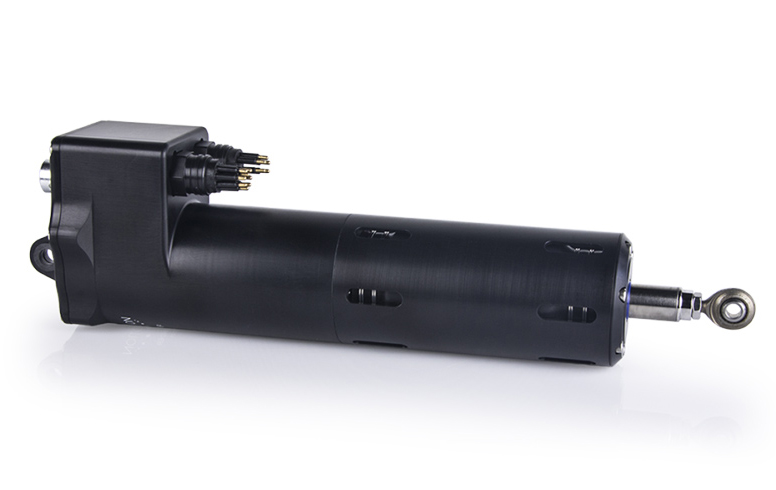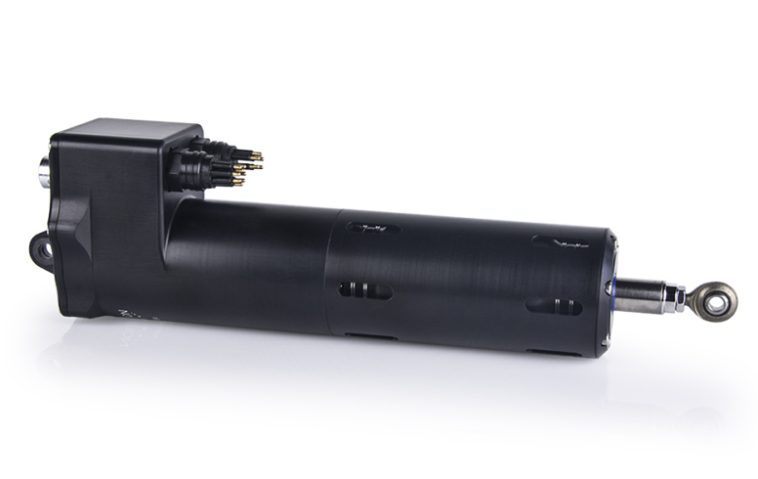
Innovative Advances in Electro-Hydraulic Actuator Technology
The industrial world is constantly evolving, and one of the most exciting recent developments has been the refinement of electro-hydraulic actuators, particularly for applications in harsh and high-moisture environments. A prime example is the enhanced version of the Regal Rexnord Thomson H-Track actuator, which now sports marine-grade, 316 stainless-steel components and a sealed motor housing. This innovation has the potential to revolutionize performance in industries as diverse as marine, agricultural, industrial, and off-highway applications. In this editorial, we take a closer look at this ground-breaking design, examine the subtle details that set it apart, and consider how it addresses the tricky parts and tangled issues of operating in corrosive environments.
With nature’s challenges rarely forgiving, designers must figure a path through a maze of issues that include moisture, salt, and temperature extremes. Traditional systems can often be overwhelming when exposed to these conditions; however, the new actuator design shows promise by offering a self-contained hydraulic system that integrates the pump, motor, and cylinder into a single, maintenance-free unit. This development not only simplifies installation but also ensures a high degree of reliability and performance under rigorous conditions.
The following discussion will dig into key improvements and examine how modifications like corrosion-resistant construction and optimized stroke length are addressing long-standing challenges. Moreover, we will treat the product as a microcosm of the larger trends influencing industrial innovation today. By examining these advancements through a neutral lens, we can better understand both the benefits and the remaining challenges that companies must work through as they deploy these systems in dynamic operational settings.
Marine-Grade Construction for Corrosion Resistance
One of the critical issues for devices operating in marine and high-humidity environments is corrosion. The use of 316 stainless steel in exposed fasteners, adapters, and piston rods answers this challenge head-on. Unlike conventional materials that may succumb to rust and oxidation, 316 stainless steel is designed to withstand salty air and moisture, making it super important for applications with prolonged exposure to such conditions.
The actuator’s components have been tested for durability through a rigorous 2,000-hour salt spray exposure, a process that many in the field find nerve-racking yet necessary to prove reliability in saltwater environments. This extended testing not only verifies the robustness of the materials but also ensures that the actuator’s performance remains steady over time – an essential characteristic for long-term investments in industrial settings.
To help visualize the improvements, consider the following table outlining a comparison between traditional actuator materials and the new 316 stainless steel components:
| Feature | Traditional Materials | 316 Stainless Steel |
|---|---|---|
| Corrosion Resistance | Prone to rust and oxidation | Highly resistant to saltwater and humidity |
| Longevity in Marine Environments | Limited durability | Tested for over 2,000 hours of salt spray exposure |
| Maintenance Requirements | Frequent checks and replacements | Designed for low-maintenance operation |
This table underlines how the new design is built to overcome the confusing bits that have long plagued traditional systems. For operators who work in environments where maintenance windows are short or unpredictable, the promise of a maintenance-free unit simply cannot be overstated.
Sealed Motor Housing: Overcoming Operational Challenges Underwater
Another standout feature of the enhanced actuator is its sealed motor housing, which has earned it an IP68 dynamic rating – a classification indicating that it is fully capable of underwater operation. This capability is especially essential for industries such as marine exploration and off-highway equipment, where equipment must function reliably even when completely submerged in water.
Sealed housings protect the motor from ingress of water and other contaminants, a critical need given that many industrial processes take place in environments that are full of problems or even off-putting in their harshness. By ensuring that the motor remains isolated from the external environment, manufacturers eliminate the nerve-wracking risk of short circuits or mechanical failure when the actuator is exposed to underwater conditions.
The sealed design is not just a superficial improvement – it represents a deep rethinking of how to combine power and safeguarding in a single package. Many in the field have noted that overly complicated pieces can lead to unexpected downtime. With a design that ensures smooth operation under a variety of conditions, this sealed motor housing is a major leap forward, allowing users to get into processes with confidence.
Below is a bullet list highlighting the main advantages offered by a sealed motor housing:
- Enhanced protection from water and dust
- Consistent performance even when fully submerged
- Increased durability in harsh, moisture-rich environments
- Reduced risk of electrical faults due to contamination
The design not only circumvents the tricky parts of environmental hazards but also offers peace of mind to operators and maintenance teams alike, ensuring that the actuator remains reliable over extended periods of service even in the most intimidating conditions.
Self-Contained Hydraulic System: Simplifying Setup and Operations
The integration of the pump, motor, and cylinder into one compact unit is a key advancement in the new H-Track design. In many traditional systems, the need for external pumps and hoses not only adds to the installation complexity but also increases the risk of component failure. By creating a self-contained hydraulic system, Regal Rexnord has managed to streamline the setup process, making installation much more straightforward.
This simplification is especially beneficial from an operational standpoint. When you rely on multiple separate components, there are many little details that can lead to delays or require specialized technicians to sort out the issues. With this all-in-one design, companies can save on both time and money during installation, and maintenance teams do not need to worry about the additional complications that come with managing multiple elements.
Some of the key operational benefits include:
- Lower overall maintenance requirements due to reduced part count
- Simplified troubleshooting processes
- Accelerated installation times, easing project timelines
- Minimized risk of failure from hose or pump issues
When an asset is built to be self-reliant in this way, it helps industrial firms steer through potentially complicated pieces of design work while ensuring that everything works together seamlessly. This approach can be seen as a broader trend in industrial innovation, where integration and smart design help companies manage their way through the bewildering maze of modern technology and infrastructure requirements.
Optimized Stroke Length and Load Configurations: Fine-Tuning for Performance
The latest actuator improvements do not simply focus on durability and ease of maintenance – they also address performance metrics by optimizing stroke lengths and load configurations. In many industrial settings, precise movement and reliable power output are super important for ensuring that machinery functions at peak efficiency.
Optimized stroke length allows the actuator to exert force over a desired range more effectively, resulting in smoother operations and improved load handling. This feature is especially beneficial when dealing with applications where precision is key. Whether a machine requires a gentle touch in agricultural equipment or a more aggressive force in industrial settings, fine-tuning these metrics makes the actuator adaptable to a wide variety of uses.
Additionally, improved load configurations mean that the actuator can be customized to suit specific operational requirements. Such adaptability minimizes the odds of encountering nerve-wracking operational failures in unexpected load conditions and helps maintain steady, reliable performance. For decision-makers in industries where every component must work harmoniously, this degree of configurability is a welcomed relief from systems that are laden with issues.
Here is a quick summary of the performance upgrades offered by improved stroke length and load configurations:
- Enhanced precision in force application
- Customization options to meet diverse industrial needs
- Smoother power delivery even under fluctuating loads
- Increased overall system reliability and operational trustworthiness
These improvements are not just technological tweaks; they represent a significant shift in how industrial designers are approaching the challenges of tailoring equipment to the exacting requirements of today’s environment. By addressing the fine points that have long been a hurdle, manufacturers are now better equipped to work through the small distinctions that separate basic performance from excellence.
Customizability and Manufacturability: Balancing Flexibility with Efficiency
Another valuable aspect of the new actuator design is its balance between refinement for manufacturability and the need for personal customization. In an industrial landscape where every application can present its own set of intimidating challenges, the ability to tailor equipment to your own operational needs is super important.
The H-Track design preserves its core benefits of being low-maintenance and highly durable, while still offering a range of customizable options. This means that whether a company is commissioning actuators for marine use or for larger industrial installations, the product can be adjusted to fit the project’s specific requirements. This level of flexibility is rare and marks an important evolution in the world of industrial automation.
Many operators appreciate that even as the design is streamlined for mass production, it remains fully configurable. This allows manufacturers to deliver products faster and more efficiently while ensuring that the end-user’s unique needs are met. Such a dual approach is particularly advantageous because it reduces the nerve-wracking risk of one-size-fits-all solutions that often require costly adaptations later on.
A bulleted list of the key benefits provided by this balanced design includes:
- Rapid production timelines without sacrificing quality
- Customizable configurations to match specific application needs
- A reduction in overall maintenance complexity
- Cost-effective solutions without compromising durability
The idea of combining streamlined production with inherent customizability is emerging as a leading trend in industrial manufacturing. Companies are increasingly looking for ways to minimize the intricate pieces of traditional engineering while still achieving the detailed settings required in modern operations. In essence, this approach takes a closer look at the hidden complexities of conventional systems and offers a refreshing alternative that is centered on operational efficiency and adaptability.
Broad Industry Implications: A New Standard in Industrial Actuation
From an industry standpoint, the introduction of this enhanced electro-hydraulic actuator is a strong signal that traditional methods are increasingly being replaced by innovative, integrated solutions. The industrial sector is currently grappling with many tangled issues related to reliability, environmental resistance, and overall efficiency. As companies across the board strive to find their way in a world where operational environments are both unpredictable and full of problems, breakthroughs like the newest H-Track actuator represent a critical evolution in technology.
One of the key implications of adopting such advanced technology is the potential for significant long-term cost savings. Maintenance costs, downtime, and the risks associated with component failures are all aspects that tend to have a big impact on the bottom line. By investing in systems that are designed to do away with the need for constant upkeep and regular repairs, organizations can allocate resources more effectively while also boosting productivity.
Moreover, the integration of such innovative solutions signals a broader shift in industry priorities: moving away from reactive maintenance practices to proactive design that anticipates and mitigates the challenges that come with operating in extreme conditions. This proactive approach is becoming increasingly essential in environments where even small operational mishaps can lead to a cascade of technical failures or unexpected costs.
Here are some key benefits industries may notice when transitioning to more advanced actuator systems:
- Reduced machine downtime thanks to fewer maintenance interruptions
- Enhanced operational safety from components that are designed for robust performance
- Simplified supply chain logistics due to integrated, self-contained systems
- Improved return on investment from long-lasting, sturdy equipment
This shift towards more resilient and self-sufficient systems not only caters to current market demands but also sets a higher bar for what companies expect from industrial equipment. The enhancements found in the latest actuator models could indeed be seen as a precursor to even greater innovations, offering a roadmap for future developments as the industry continues to evolve.
Addressing the Tangled Issues of Harsh Environment Operations
For many operators, the move to adopt robust and customizable actuators is a decision made out of necessity rather than luxury. The operational challenges present in harsh environments – whether in industrial, marine, or agricultural settings – are numerous and can often feel overwhelming. Yet, when faced with off-putting environmental factors like humidity, salt, and corrosive conditions, engineers have been forced to figure a path that successfully balances durability with performance.
Modern electro-hydraulic actuators play an instrumental role in this balancing act by addressing the nerve-wracking risks that come with harsh, moisture-rich settings. The streamlined design that incorporates both corrosion-resistant materials and a sealed motor housing is a testament to the industry’s commitment to solving these problems. Instead of getting entangled in the confusing bits of frequent maintenance and operational failures, operators can now count on a design that minimizes such setbacks.
The strength of the new actuator is in its thoughtful design that alleviates many of the twists and turns historically associated with traditional systems. Not only does it handle water and humidity with ease, but it also offers ease of installation and reliable long-term performance – a combination that operators in every industry will find reassuring.
This approach reflects a broader industry trend, where the emphasis is increasingly on creating systems that are both adaptable and robust. By addressing the small distinctions that separate a good product from a great one, manufacturers provide customers with equipment that adapts easily to fluctuating conditions while maintaining consistent performance. This progress is a welcome relief for many professionals who have long been frustrated by the nerve-racking challenges posed by older technology.
Balancing Cost-Effectiveness With High Performance
A critical discussion point in any technological upgrade involves the trade-off between cost and performance. Historically, companies have had to weigh the considerable upfront investment in high-performance components against the long-term costs associated with high maintenance requirements. The evolution of the H-Track actuator reflects not only a technological breakthrough but also a strong case for cost-effective innovation.
Because this new actuator design eliminates the need for external pumps, complex hose networks, and frequent maintenance, companies can expect to see reductions in both operational headaches and unforeseen repair bills down the road. The cost-saving implications are evident when you compare the typical expenses incurred from a multi-component setup versus the streamlined, integrated unit offered by Regal Rexnord.
When thinking about this balance, consider the following factors:
- Lower Initial Maintenance Costs: The self-contained nature of the actuator reduces the need for ongoing servicing, saving money over the long term.
- Reduced Downtime: With fewer parts to fail, downtime is minimized, ensuring smoother operations and a more consistent production schedule.
- Improved ROI: A unit that performs reliably under harsh conditions yields long-term financial benefits through decreased operational disruptions.
- Streamlined Operational Processes: Simplified installation and reduced complexity free up resources to invest in other critical areas of the business.
These cost benefits are not merely speculative but are being actively recognized by companies that invest in such advanced solutions. As businesses continue to face intense competition along with economic pressures, innovations that reduce overall overhead while improving performance are not just attractive – they are essential.
This balance of cost-effectiveness with high performance also speaks to a broader philosophy in industrial technology: the need to work through the tricky parts of development without compromising quality. By focusing on reliability and ease of use, new actuator systems like the H-Track are setting a new standard that blends financial prudence with operational excellence.
Future Perspectives: Where Do We Go From Here?
Looking ahead, it is clear that the advancements in actuator technology represent more than just an incremental improvement – they hint at a future where industrial design is more integrated, resilient, and adaptive. While the current generation of devices significantly reduces the problems of corrosion, maintenance, and performance inefficiencies, they also pave the way for further innovations that may integrate smart sensor technology, remote monitoring, and predictive maintenance features.
Many experts expect that by digging into the hidden complexities of industrial applications, future versions of these actuators could incorporate connectivity with digital control systems. Such benefits would allow operators to get into real-time condition monitoring, thereby catching potential issues before they escalate into full-blown operational failures. This proactive strategy is a notable divergence from the traditional reactive maintenance model that has long been the norm in the industry.
Moreover, the current trend toward lower maintenance, integrated systems, and customized configurations suggests a broader shift in how manufacturers design industrial equipment. In an age where almost every part of the supply chain is under scrutiny for efficiency and sustainability, having machinery that can adapt seamlessly to evolving conditions isn’t just a bonus – it’s a necessity.
In addition, it is worth noting that the impact of these design improvements extends beyond just the hardware. The related benefits include simplified workforce training, reduced dependency on specialized repair teams, and the possibility of standardized parts across diverse applications. These subtle benefits collectively add up to a system that not only performs exceptionally well but also is easier for companies to manage in the long run.
As industries continue to work their way through the challenging bits of modern manufacturing and operational efficiency, innovations such as the enhanced H-Track actuator serve as both a benchmark and inspiration. They remind us that even in an era marked by complicated pieces of technology, there is still ample room for smart, efficient, and cost-effective designs that take the initiative to sort out issues before they become insurmountable.
Embracing Technological Breakthroughs While Managing Expectations
While the new actuator technology offers many exciting benefits, it is also important for stakeholders to maintain a balanced perspective regarding its implementation and future growth. In any sector where operational conditions are loaded with issues and environmental factors are both variable and intense, there is always the potential for unforeseen complications to arise.
As companies begin to integrate these systems, they should be aware that even the most well-engineered components can encounter unexpected challenges in unique operating environments. That said, building in redundancies, routinely checking system performance, and working closely with manufacturers on tailored solutions can mitigate many of these nerve-wracking possibilities.
Industry leaders must also be prepared for ongoing evolution – while the current actuator design is impressive, it is not the endpoint but rather a step in an ongoing journey of refinement and improvement. With digital transformation and smart technologies continuing to advance, it’s reasonable to expect that future models may offer even more advanced features, such as:
- Remote diagnostic capabilities to figure a path through maintenance and troubleshooting
- Integration with automated control systems for improved operational oversight
- Real-time data analytics to monitor performance under varied conditions
- Adaptive control features that automatically adjust load and stroke parameters
These enhancements would allow for a far more comprehensive solution, one where the actuator not only performs its basic functions reliably but also communicates its health and status to operators, thus pre-empting many of the tangled issues that have historically resulted in unexpected downtime. Such a scenario would represent a major turning point for industries that have long been burdened by the intimidating challenge of balancing performance with durability.
Integrating Advanced Actuation Systems Into Modern Industrial Strategy
For business leaders and engineers alike, embracing these technological breakthroughs is readily becoming a key part of a modern industrial strategy. With tighter margins, competitive pressures, and the ever-present need for operational flexibility, investing in components that are designed to perform in harsh conditions is not just a tactical move—it is a strategic imperative.
Understanding the specific requirements of various applications—whether marine, agricultural, or industrial—is essential. The actuator’s design, which includes aspects such as corrosion-resistant materials, ease of installation, and customizability, provides a template for how technology must evolve to meet these diverse demands. Companies now have the opportunity not only to reduce their immediate maintenance costs but also to streamline operations in a way that positions them favorably in a market that is both competitive and unpredictable.
Key strategies for incorporating advanced actuation systems include:
- Conducting a thorough needs analysis: Evaluate the operational environment to identify the precise conditions and performance metrics required.
- Engaging with manufacturers for customized solutions: Work closely with design teams to ensure that the hardware aligns with both current and future needs.
- Investing in training and support: Equip your workforce with the knowledge to handle integrated systems, reducing the learning curve when issues arise.
- Maintaining flexibility: Choose systems that allow for adjustments and upgrades as operational demands evolve.
By adopting such strategies, companies can not only embrace the enhanced performance of modern actuators but also ensure that their broader operational framework is robust enough to accommodate upcoming shifts in technology and market dynamics. This integrated approach to hardware and strategy can lay the foundation for sustained growth and resilience in a sector that is constantly in flux.
Conclusion: A Bold Step Forward for Industrial Innovation
The introduction of the enhanced Regal Rexnord Thomson H-Track actuator marks a decisive milestone in the evolution of industrial automation and performance engineering. With its marine-grade, 316 stainless-steel construction, sealed motor housing for underwater operation, and an integrated self-contained hydraulic system, this actuator addresses many of the nerve-wracking issues that have long troubled traditional designs. By simplifying installation, reducing maintenance complexity, and optimizing performance metrics such as stroke length and load configurations, it sets a new standard that is both cost-effective and highly efficient.
Industries that operate in environments where every small twist and turn of technology can lead to significant operational differences are taking note. Operators and decision-makers now have a reliable, customizable option that not only mitigates the tricky parts and tangled issues of corrosion and environmental degradation but also paves the way for a future where smart, integrated systems become the norm.
As we look ahead, it becomes clear that this evolution in actuator design is part of a broader trend toward smarter, more sustainable industrial technology. The ability to anticipate problems before they escalate, coupled with the promise of remote diagnostics and enhanced performance monitoring, ensures that these advancements will not just meet today’s challenges but also adapt to tomorrow’s uncertainties.
In summary, embracing the innovations exemplified in this advanced actuator design is a bold step forward for the industrial sector. By balancing durability, performance, and cost-effectiveness, companies can confidently work their way through the complicated pieces and overwhelming demands of modern manufacturing environments. Ultimately, initiatives like these showcase that even in a landscape rife with challenges, continuous improvement and technological ingenuity pave the way for sustainable progress and economic growth.
Originally Post From https://www.controlglobal.com/manipulate/actuators/product/55311932/regal-rexnord-stainless-steel-electro-hydraulic-actuator-has-sealed-motor-for-underwater-service
Read more about this topic at
Water resistant linear actuator
Expanded electrohydraulic actuator offers marine-grade …


